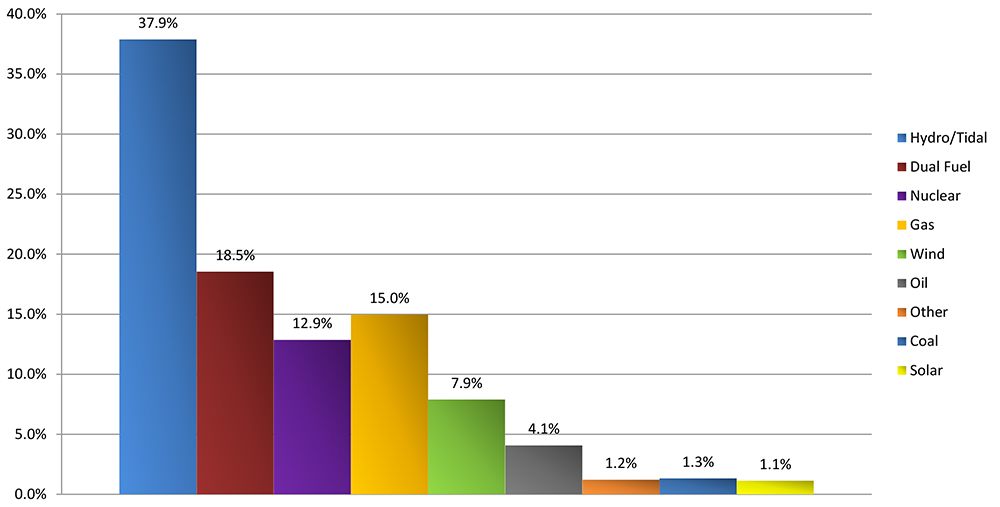
Canada’s Ontario and Maritimes provinces may have to rely on energy imports and operating procedures to meet energy needs this summer, the Northeast Power Coordinating Council said this week; however, the regional entity expects no other challenges for utilities in its footprint.
NPCC’s 2023 Summer Reliability Assessment, released on Wednesday, reported that the region — which includes the six New England states, New York, Québec, Ontario and the Maritimes (New Brunswick and Nova Scotia) — is expected to have about 158,800 MW of installed capacity for the months of June, July and August. That figure includes projects expected to be in service over the course of the summer and represents a decrease of about 600 MW from last summer. (See NPCC Predicts Tighter Margins for Summer 2022.)
Adding in 2,144 MW of net interchange, representing purchases and sales with areas outside NPCC, and 2,313 MW in dispatchable demand-side management assets, the region is expected to have 163,338 MW of total capacity for the summer.
The coincident peak demand during NPCC’s peak week, beginning Aug. 20, is 105,200 MW, up from the 104,601 MW predicted for last year’s peak week of July 24. During that week the net margin will be 10,047 MW, slightly tighter than last year’s peak week margin forecast of 11,586 MW.
 NPCC’s predicted resource fuel types for the week beginning Aug. 20 | NPCC
NPCC’s predicted resource fuel types for the week beginning Aug. 20 | NPCC
Overall demand figures are based on a 50/50 system load forecast, representing a prediction with a 50% chance of being exceeded. Like last year, the assessment also includes a 90/10 forecast, which has a 10% chance of being exceeded, and an “above 90/10” forecast representing a “low-probability, high-impact composite scenario [relying] heavily on individual area risk assumptions.” Under the 90/10 forecast, net margin shrinks to 4,090 MW, while the most extreme scenario results in a deficit of 7,270 MW for the region.
While the majority of NPCC’s subregions report adequate margin for at least the 50/50 scenario, Ontario is currently predicting negative margins for multiple weeks under the 50/50, 90/10 and above-90/10 forecasts. This is largely because of planned generator outages during those weeks.
Ontario’s forecasted peak demand is 22,439 MW for the 50/50 scenario, 24,420 MW for 90/10, and 27,021 for above 90/10. The area’s peak week begins July 23 under the 50/50 and above-90/10 scenarios and July 16 in the 90/10 scenario. Because of generation additions including two new hydroelectric plants, the area’s generation has experienced a net increase since last summer of 178 MW.
NPCC said that Ontario’s deficits may require its Independent Electricity System Operator to call on imports from neighboring jurisdictions or “additional operating actions,” even during 50/50 conditions. However, the RE also acknowledged that IESO is working with generation owners to reschedule the outages scheduled for these weeks. Noting the amount of system upgrades and maintenance scheduled over the next few years, NPCC “strongly encouraged” market participants to coordinate with IESO so that outages can be scheduled appropriately.
Other than the Maritimes provinces, which show “a likelihood of using their operating procedures,” including reducing their 30-minute reserves and initiating interruptible loads to mitigate resource shortages during the 50/50 scenario, no other area expects to have issues meeting demand this summer. Regional forecasts under the 50/50 and 90/10 scenarios are:
- Maritimes: peak demand of 3,612 MW (50/50) and 3,845 MW (90/10), with total capacity for peak week of 7,775 MW under both scenarios. Two solar farms are expected to enter service before or during summer, while a hydro station is expected to be retired, resulting in a 9-MW net increase in capacity.
- ISO-NE: peak demand of 24,664 MW (50/50) and 26,479 MW (90/10); total peak week capacity of 30,346 MW. The addition of about 3,500 MW of behind-the-meter solar PV and 2,004 MW of energy efficiency demand reductions is expected to reduce peak load by nearly 3,000 MW.
- NYISO: peak demand of 32,049 MW (50/50) and 33,883 MW (90/10); total peak week capacity of 41,374 MW. New York’s resource additions include 556 MW of land-based wind, although the retirement of several combustion generators means a 205-MW decrease in installed capacity from last summer.
- Québec: peak demand of 22,859 MW (50/50) and 23,900 MW (90/10); total peak week capacity of 44,654 MW. NPCC said the province is expecting no issues with resource adequacy and “is prepared to assist other areas, if needed.”

